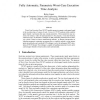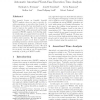17 search results - page 1 / 4 » Automatic Identification of Timing Anomalies for Cycle-Accur... |
DDECS
2006
IEEE
13 years 8 months ago
2006
IEEE
Abstract-- Hard real-time systems need methods to determine upper bounds for their execution times, usually called worst-case execution times. Timing anomalies are counterintuitive...
ECRTS
2009
IEEE
13 years 2 months ago
2009
IEEE
This paper explores timing anomalies in WCET analysis. Timing anomalies add to the complexity of WCET analysis and make it hard to apply divide-and-conquer strategies to simplify ...
CASES
2006
ACM
13 years 8 months ago
2006
ACM
This paper proposes an efficient method to analyze worst case interruption delay (WCID) of a workload running on modern microprocessors using a cycle accurate simulator (CAS). Our...
WCET
2003
13 years 6 months ago
2003
Worst-Case Execution Time (WCET) analysis means to compute a safe upper bound to the execution time of a piece of code. Parametric WCET analysis yields symbolic upper bounds: expr...
WCET
2007
13 years 6 months ago
2007
Our research focuses on formally bounded WCET analysis, where we aim to provide absolute guarantees on execution time bounds. In this paper, we describe how amortisation can be us...


